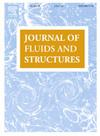更高的共振提高了柔性仿生推进器的游泳性能
IF 3.5
2区 工程技术
Q1 ENGINEERING, MECHANICAL
引用次数: 0
摘要
本研究建立了高共振频率对柔性仿生推进器游泳性能的影响。生物和仿生游泳者通常在他们的第一共振处或附近游泳,以达到高效率和推力。这些游泳者也有更高的共振,可以产生同样的性能优势;然而,这些高共振的作用还没有得到很好的理解。本研究通过实验确定了柔性推进器跨共振的推力、运动学和动力性能,并揭示了控制性能的流固机制。我们实验测试了多个推进器,它们共享一个简化的设计,包括在静水中由压电致动器激发的恒定截面光束,其刚度在生物游泳者的范围内。我们的研究结果表明,与基本共振相比,更高的共振显著提高了性能,使推力功率比增加了2倍,绝对推力增加了11倍,而位移幅度需要<;25%。虽然较高的共振产生更好的整体性能,但由于推力系数取决于模态振型,因此较高的共振在将尾速度转换为推力时效果较差。我们确定较高的共振占用较少的流体质量,并表明有效纵横比(波长按宽度归一化)是跨共振性能的预测因子。这些结果表明,更高的共振可能是一种可行的游泳选择,可以提高身体较硬的游泳者的推力和效率,同时产生更小的位移振幅,从而改善在障碍物附近的操作。本文章由计算机程序翻译,如有差异,请以英文原文为准。
Higher resonances improve the swimming performance of flexible bio-inspired propulsors
This study establishes the role of higher resonant frequencies on the swimming performance of flexible bio-inspired propulsors. Biological and bio-inspired swimmers typically swim at or near their first resonance to achieve high efficiency and thrust. These swimmers also have higher resonances that could yield the same performance benefits; however, the role of these higher resonances is not well understood. This study experimentally identifies the thrust, kinematics, and power performance of flexible propulsors across resonances and uncovers the fluid-structural mechanism that governs the performance. We experimentally test multiple propulsors that share a simplified design consisting of a constant cross-section beam excited by piezoelectric actuators in quiescent water and with stiffnesses in the range of biological swimmers. Our results demonstrate that higher resonances significantly improve the performance compared to the fundamental resonance yielding a increase in thrust to power ratio, up to increase in absolute thrust, while requiring of the displacement amplitude.
While the higher resonances yield better overall performance, we show that higher resonances are less effective at converting tail velocity into thrust since the thrust coefficient depends on the mode shape. We determine that higher resonances engage less fluid mass, and show that the effective aspect ratio (wavelength normalized by width) is a predictor of performance across resonances. These results indicate that higher resonances could be a viable swimming option to improve the thrust and efficiency of stiffer bodied swimmers while yielding smaller displacement amplitudes that improve operation near obstacles.
求助全文
通过发布文献求助,成功后即可免费获取论文全文。
去求助
来源期刊

Journal of Fluids and Structures
工程技术-工程:机械
CiteScore
6.90
自引率
8.30%
发文量
173
审稿时长
65 days
期刊介绍:
The Journal of Fluids and Structures serves as a focal point and a forum for the exchange of ideas, for the many kinds of specialists and practitioners concerned with fluid–structure interactions and the dynamics of systems related thereto, in any field. One of its aims is to foster the cross–fertilization of ideas, methods and techniques in the various disciplines involved.
The journal publishes papers that present original and significant contributions on all aspects of the mechanical interactions between fluids and solids, regardless of scale.
 求助内容:
求助内容: 应助结果提醒方式:
应助结果提醒方式:


